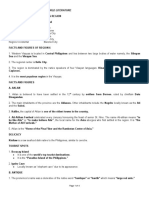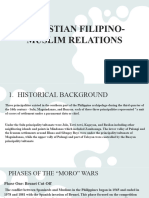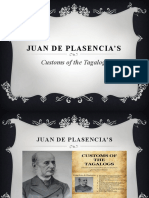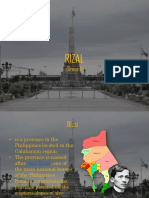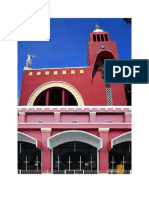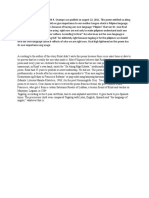More of Malabon Landmarks
More of Malabon Landmarks
Uploaded by
Rosie FloranteCopyright:
Available Formats
More of Malabon Landmarks
More of Malabon Landmarks
Uploaded by
Rosie FloranteOriginal Description:
Copyright
Available Formats
Share this document
Did you find this document useful?
Is this content inappropriate?
Copyright:
Available Formats
More of Malabon Landmarks
More of Malabon Landmarks
Uploaded by
Rosie FloranteCopyright:
Available Formats
More of Malabon Landmarks
Malabon as it is today is a thriving commercial and industrial urban city,
rich in marine resources and a productive fishing industry. It has
contributed much to the economy of the region and has also become a
manufacturing base as well. It also has many worthwhile attractions one
should definitely visit to get a grasp of the historic yet progressive
character of the city.
Balsa sa Niugan
Started in July 1998, Balsa sa Niugan is owned by Mr. Santy Geronimo, a
native from Niugan. It has a total land area of 5,000 sq. meters, in both
land and water. Located at the heart of Malabon, Balsa was originally a
fishpond converted into a floating restaurant and a fishing garden. Its
natural landscape, fishing and open dining facilities make it a pleasurable
place for guests to dine.
Epifanio Cristobal Delos Santos Monument
Generally regarded as the foremost scholar, Epifanio de los Santos, a
Malabon native, reaffirms what the Filipino can accomplish with his native
genius & ability coupled with proper background & incentive. With the
possible exception of Rizal, Epifanio de los Santos went one step further
than most of the brilliant minds that preceded him because of his
versatility.
Gregorio Gozon Sanciangco's Historical Marker
A native of Tonsuya, Malabon, Gregorio Gozon Sanciangco is the son of
Eladio Sanciangco and Regina Gozon. He started schooling at an early age
until he finished his Bachelor’s degree from Colegio de San Juan de Letran
and his course in Law at the University of Santo Tomas. In 1878, Gregorio
Sanciangco left for Spain to enroll in the Universidad Central de Madrid
where he was conferred the title of Doctor of Laws and a Licensure in
Administrative Law.
He wrote "EL PROGRESO DE FILIPINAS", a book on economic and
political studies of the Philippines. It advocated reforms in the political,
administrative, agrarian, revenues, property, natural resources and urban
development, taxation and proposed legislation for the implementation of
such reforms. Because of this book, he was given tribute by Dr. Jose P.
Rizal in the introduction of his work Sobre La Indolencia delos Filipinos.
Angel C. Cacnio's Art Gallery
The gallery is a depository of paintings and sculptures done by the noted
members of the Sining Tambobong Foundation. Contemporary and
Modern Malabon painters and sculptors are members of this Foundation.
Their works are displayed in both national and international art
exhibitions.
Residence of Luis Santos Jr.
It is a collection of revolutionary documents and Spanish artifacts.
Malabon's contributions to the nation’s history for independence are
reflected from the display of various revolutionary materials used by the
revolutionary soldiers of Malabon.
Tanong Fish Market
Visit Malabon and experience the traditional native fish trading called
"BULUNGAN". Bulungan is a bidding practice that started during the
Spanish era at the fishing market along the Malabon - Navotas River and is
still being done up to this day at the Tanong Fish Market. This kind of fish
trading culture is preserved and handed down from one generation to
another. It is unique and distinctively Malabon because it does not follow
the normal process of bidding. Instead, the spirit of bidding to know the
highest bidder is not documented but rather done secretly through silent
whispering of bidders' pricing. In essence, this practice is to sell fish to
retailers in Metro Manila and other provinces. Fish traders come from the
fish ports of Navotas and nearby provinces particularly Bulacan. Usual
active time of Bulungan is from 9:00 PM to 1:00 AM.
San Bartolome Church
It is a known fact that the history of the Philippines is relevant to the
growth of Christianity. Without exemption, this was the experience of the
historical path of San Bartolome Church. Tambobong, the original name of
Malabon was founded as a visita of Tondo on May 21, 1599 and continued
as such until 1611. The term visita refers to a town or barrio not erected yet
as an independent town or parish. In 1614, it was made as an independent
parish and on the 17th of May 1614, Fr. Luis Gutierrez, OSA, became the
first parish priest. From 1614 up to 2003 a total of 101 priests served the
church.
Chung-Gu Korea Friendship Park
This park is dedicated to give life and meaning to the city's desire to
establish the real foundation for a lasting world peace through the
furtherance of better understanding and friendly relations with our
neighboring countries. It was constructed with the hope of further
strengthening the friendship ties between the people of Malabon City,
Philippines and the people of Chung-Gu District, Taejon City, Korea.
Malabon Zoo and Aquarium
A well kept and unique conservatory of both endemic and exotic animals,
including a large variety of unusual fishes stashed inside a one-hectare
tropical rainforest environment. An amusing destination for the old and
the young, it indulges its visitors with the distinct privilege to pet wild
animals that normally avoid human contact. The zoo is likewise an
accommodating classroom for nature lovers because it educates people on
environmental preservation of forests and wildlife.
You might also like
- Thomas StowageDocument52 pagesThomas StowageRalf Tholen100% (5)
- Pigafettas Chronicles PDFDocument14 pagesPigafettas Chronicles PDFArgine Acojedo AbuganNo ratings yet
- Malabon Heritage TourDocument23 pagesMalabon Heritage TourRosie Florante100% (2)
- 1947-1958 Industrialization of PakistanDocument43 pages1947-1958 Industrialization of PakistanSadiya Azhar73% (11)
- Region ViDocument4 pagesRegion ViGarcia, Rafael Rico O.No ratings yet
- Readings in Philippine History: ActivityDocument6 pagesReadings in Philippine History: Activityjessie sandoyNo ratings yet
- Antonio Pigafetta's First Voyage Around The World: A TravelogueDocument3 pagesAntonio Pigafetta's First Voyage Around The World: A TravelogueGerome RosarioNo ratings yet
- Raiders of The Sulu Sea Author'S Background: Context Oak3 Films: Halman AbubakarDocument3 pagesRaiders of The Sulu Sea Author'S Background: Context Oak3 Films: Halman AbubakarDrinnie Mae Simon BernardoNo ratings yet
- Region 4B57Document36 pagesRegion 4B57Rey John NabaysanNo ratings yet
- Juan de Plasencia's Customs of The TagalogDocument5 pagesJuan de Plasencia's Customs of The TagalogMeeka Marasigan CarriteroNo ratings yet
- FIRST VOYAGE AROUND THE WORLD BY MAGELLAN of Antonio PigafettaDocument1 pageFIRST VOYAGE AROUND THE WORLD BY MAGELLAN of Antonio PigafettaTech UserNo ratings yet
- Ge02 CHP 4 l1 Monastic Supremacy in The Philippines Merged CompressedDocument73 pagesGe02 CHP 4 l1 Monastic Supremacy in The Philippines Merged CompressedJacoba, Michaela JasmineNo ratings yet
- Philippine Local & Oral HistoryDocument28 pagesPhilippine Local & Oral HistoryEyespoppedNo ratings yet
- The Battle of Tirad PassDocument8 pagesThe Battle of Tirad PassArianne Pangilinan100% (1)
- Reflection PaperDocument1 pageReflection PaperFaizal MaligaNo ratings yet
- Christian Filipino-Muslim RelationDocument34 pagesChristian Filipino-Muslim Relationaveguil mabilin100% (1)
- Sakdal MovementDocument21 pagesSakdal Movementmichaelmuplayer5855No ratings yet
- Barasoain Church, Bulacan: Juan Giron Magpayo Circle MotifDocument35 pagesBarasoain Church, Bulacan: Juan Giron Magpayo Circle MotifRenz Jason SisonNo ratings yet
- Grp3 Monastic SupremacyDocument48 pagesGrp3 Monastic Supremacyjoeyisms82% (11)
- A Brief Summary of The First Voyage Around The World by Magellan by Antonio PigafettaDocument3 pagesA Brief Summary of The First Voyage Around The World by Magellan by Antonio PigafettaAngelyn BernardoNo ratings yet
- Pre ColonialDocument2 pagesPre ColonialSamantha CelizNo ratings yet
- Maayong Adlaw! Tara Na Sa Hilagang Kamindanawan!!Document41 pagesMaayong Adlaw! Tara Na Sa Hilagang Kamindanawan!!Mariane Louise BatacNo ratings yet
- Chapter 2 Understanding The Significance of Primary SourcesDocument34 pagesChapter 2 Understanding The Significance of Primary SourcesCASIMERO, KENJI B.No ratings yet
- The KKK and Kartilya NG Katipunan: Group 1Document47 pagesThe KKK and Kartilya NG Katipunan: Group 1Satoshi AkatsukiNo ratings yet
- Juan de Plasencia Group 2 - 2Document26 pagesJuan de Plasencia Group 2 - 2Jancint CoronadoNo ratings yet
- Chap 6 - Challenges To Spanish AuthorityDocument6 pagesChap 6 - Challenges To Spanish AuthorityPark Min YeonNo ratings yet
- First Voyage Around The World: Context and Content Analysis ofDocument30 pagesFirst Voyage Around The World: Context and Content Analysis ofStephanie Joy Sanchez GarcesNo ratings yet
- Kartilya NG KatipunanDocument5 pagesKartilya NG KatipunanScott Woodrow Suganob100% (1)
- History of RizalDocument41 pagesHistory of RizalChloei Cassandra BarbosaNo ratings yet
- AguilarDocument7 pagesAguilarLovely CarbonelNo ratings yet
- On Philippine Revolts and RevolutionDocument32 pagesOn Philippine Revolts and RevolutionJr Ocampo100% (1)
- Sucesos de Las Islas Filipinas: Learning OutcomeDocument3 pagesSucesos de Las Islas Filipinas: Learning Outcomeaelin feyreNo ratings yet
- GRP 3 REPORT The Morga and RIzals Search For OriginsDocument74 pagesGRP 3 REPORT The Morga and RIzals Search For OriginsMichelle VillarandaNo ratings yet
- Readings in Philippine History MidtermDocument5 pagesReadings in Philippine History MidtermJoseph AlianicNo ratings yet
- The Beauty of Puerto GaleraDocument15 pagesThe Beauty of Puerto Galeramargejoy ramosNo ratings yet
- The Relazione Del Primo Viaggio Intorno Al MondoDocument1 pageThe Relazione Del Primo Viaggio Intorno Al MondoBasil Francis AlajidNo ratings yet
- Aaaaaaaaaaaaaaaaaaaaaaaaaaagaaa Aaaaaaa Aaaaaaaaaaaaaaaaaaa AaaaaDocument2 pagesAaaaaaaaaaaaaaaaaaaaaaaaaaagaaa Aaaaaaa Aaaaaaaaaaaaaaaaaaa AaaaaDoris Lagura Pamplona100% (1)
- St. Michaels CathedralDocument36 pagesSt. Michaels CathedralSEcREtNo ratings yet
- Activity 2 03242021Document4 pagesActivity 2 03242021Michael John SerdanNo ratings yet
- Summary of KartilyaDocument12 pagesSummary of KartilyaAshianna MonteroNo ratings yet
- Sucesos Delas IslasDocument19 pagesSucesos Delas IslasMarifel PatulotNo ratings yet
- BataanDocument6 pagesBataancathyNo ratings yet
- Rise of Filipino NationalismDocument68 pagesRise of Filipino NationalismDANIELLA JOIZ MARI DIAZNo ratings yet
- Module 3. One Past But Many Histories Controversies .... 9 15 2020 PDFDocument32 pagesModule 3. One Past But Many Histories Controversies .... 9 15 2020 PDFEina Delos SantosNo ratings yet
- History With Lourd The Greatest Hoaxes in Philippine HistoryDocument3 pagesHistory With Lourd The Greatest Hoaxes in Philippine HistoryLeticia CarandangNo ratings yet
- Papa AssignmentDocument2 pagesPapa AssignmentPamintuan, MikkoNo ratings yet
- Social Science and Philosophy: (Philippine Indigenous Community)Document33 pagesSocial Science and Philosophy: (Philippine Indigenous Community)Chabelita EleazarNo ratings yet
- Group 1 First Voyage Around The WorldDocument5 pagesGroup 1 First Voyage Around The WorldDO RE NANo ratings yet
- RPH-FINALS - Andes, Juvic A. - BSA1G2Document14 pagesRPH-FINALS - Andes, Juvic A. - BSA1G2Juvic AndesNo ratings yet
- Readings in Philippine History Chapter 10 - PUGAD LAWIN, BALINTAWAK, OR TORODocument29 pagesReadings in Philippine History Chapter 10 - PUGAD LAWIN, BALINTAWAK, OR TOROJHON MICCO ERGINANo ratings yet
- Riph Midterm QuizDocument4 pagesRiph Midterm QuizChini RuizNo ratings yet
- First Voyage Around The World by MagellanDocument18 pagesFirst Voyage Around The World by MagellanChristian Reyl B. Flores100% (1)
- Customs of The TagalogsDocument5 pagesCustoms of The Tagalogsjuliane san juanNo ratings yet
- Rizal's Life: Family: Reporters: James Edrian Rubio & Francis John Paul Sarayan Bsce - 1ADocument29 pagesRizal's Life: Family: Reporters: James Edrian Rubio & Francis John Paul Sarayan Bsce - 1AJamED ALRubioNo ratings yet
- Sa Aking Mga Kabata by Ambeth 1Document1 pageSa Aking Mga Kabata by Ambeth 1Rey Jr AlipisNo ratings yet
- First Cry of Balintawak or PugadlawinDocument21 pagesFirst Cry of Balintawak or PugadlawinPjungNo ratings yet
- History of Malabon CityDocument13 pagesHistory of Malabon CityELSA ARBRENo ratings yet
- Enabling Stakeholders of Coron PDFDocument11 pagesEnabling Stakeholders of Coron PDFDevie Filasol100% (1)
- Historical PlacesDocument37 pagesHistorical PlacesGrace MedinaNo ratings yet
- CALOOCANDocument12 pagesCALOOCANFeliciano LandichoNo ratings yet
- The Philippine Agricultural Review Vol. VIII, First Quarter, 1915 No. 1From EverandThe Philippine Agricultural Review Vol. VIII, First Quarter, 1915 No. 1No ratings yet
- Labong" (Plenty of Bamboo Shoots) - This Was Originally Called As TambobongDocument10 pagesLabong" (Plenty of Bamboo Shoots) - This Was Originally Called As TambobongRosie FloranteNo ratings yet
- Bonifacio featureDocument1 pageBonifacio featureRosie FloranteNo ratings yet
- Major DecisionsDocument1 pageMajor DecisionsRosie FloranteNo ratings yet
- John Hay Take OverDocument2 pagesJohn Hay Take OverRosie FloranteNo ratings yet
- Labong" (Plenty of Bamboo Shoots) - This Was Originally Called As TambobongDocument10 pagesLabong" (Plenty of Bamboo Shoots) - This Was Originally Called As TambobongRosie FloranteNo ratings yet
- Letter To SelfDocument1 pageLetter To SelfRosie FloranteNo ratings yet
- Percussion InstrumentsDocument1 pagePercussion InstrumentsRosie FloranteNo ratings yet
- Audio Visual PO Group3 Write UpDocument3 pagesAudio Visual PO Group3 Write UpRosie FloranteNo ratings yet
- Nonoy Marcelo - Famous CartoonistDocument3 pagesNonoy Marcelo - Famous CartoonistRosie FloranteNo ratings yet
- Remnants of Spanish Era Commerce in Malabon: La Princesa TabacaleraDocument4 pagesRemnants of Spanish Era Commerce in Malabon: La Princesa TabacaleraRosie FloranteNo ratings yet
- The Tranvia: Part and Parcel of Malabon's Proud HistoryDocument4 pagesThe Tranvia: Part and Parcel of Malabon's Proud HistoryRosie FloranteNo ratings yet
- English: Quarter 1 - Module 1: Parts of A Simple ParagraphDocument23 pagesEnglish: Quarter 1 - Module 1: Parts of A Simple ParagraphRosie FloranteNo ratings yet
- Gregorio Sanciangco, Prominent Son of MalabonDocument2 pagesGregorio Sanciangco, Prominent Son of MalabonRosie FloranteNo ratings yet
- 2019 ImasDocument2 pages2019 ImasRosie FloranteNo ratings yet
- English Q1 M2Document27 pagesEnglish Q1 M2Rosie Florante0% (1)
- Science Q1 M1 FinalDocument15 pagesScience Q1 M1 FinalRosie FloranteNo ratings yet
- Sop-Special Characteristics IdentificationDocument3 pagesSop-Special Characteristics IdentificationSaravana kumar NagarajanNo ratings yet
- 167-2013 RegulationDocument51 pages167-2013 RegulationHüseyin BarışNo ratings yet
- Patriot Sports HandbookDocument5 pagesPatriot Sports Handbookapi-27171334No ratings yet
- Modern Floorplans An Average Modern Shopping MallDocument62 pagesModern Floorplans An Average Modern Shopping MallJackNo ratings yet
- Spectrum Security Services Vs - David GraveDocument2 pagesSpectrum Security Services Vs - David GraveJuna Aimee FranciscoNo ratings yet
- Modified Basic Education Enrollment Form: Annex 1Document2 pagesModified Basic Education Enrollment Form: Annex 1Julhan GubatNo ratings yet
- Summary of Driver Perception-Reaction Time Research Test ConditionsDocument1 pageSummary of Driver Perception-Reaction Time Research Test ConditionsPaul BeavisNo ratings yet
- Selection of SiteDocument3 pagesSelection of SiteJaideHizoleSapul100% (1)
- Recruitingguide 2010Document32 pagesRecruitingguide 2010srujan chowdaryNo ratings yet
- M.B.M. Engineering College Department of Architecture and Town Planning Jai Narain Vyas University, JodhpurDocument82 pagesM.B.M. Engineering College Department of Architecture and Town Planning Jai Narain Vyas University, JodhpurManvi SharmaNo ratings yet
- Niranjan ResumeDocument2 pagesNiranjan ResumeNayeem BashaNo ratings yet
- Implementation Plan Enhanced Community Immersion Program Public Safety Basic Recruit Course RTC 10 Class 2020-01 Alpha To Charlie CompanyDocument3 pagesImplementation Plan Enhanced Community Immersion Program Public Safety Basic Recruit Course RTC 10 Class 2020-01 Alpha To Charlie CompanyJV DeeNo ratings yet
- PP Ch03Document35 pagesPP Ch03FistareniNirbitaWardhoyoNo ratings yet
- Suggested Answers To 2013 Remedial Law Bar Exam Essay QuestionsvbcgxhghDocument13 pagesSuggested Answers To 2013 Remedial Law Bar Exam Essay QuestionsvbcgxhghMalvin Aragon Balleta100% (1)
- Quality Gates Concept PDFDocument38 pagesQuality Gates Concept PDFjay2kay5793No ratings yet
- Nstp2 Theories of LearningDocument39 pagesNstp2 Theories of Learningrex danielle100% (1)
- EthicsDocument37 pagesEthicsMisheck MarengaNo ratings yet
- Ched-Marina Moa PDFDocument45 pagesChed-Marina Moa PDFChes Vergara100% (1)
- Catalouge 12Document68 pagesCatalouge 12Bedra MelikeNo ratings yet
- TQM Questions and AnswersDocument19 pagesTQM Questions and AnswersYogeesha HC100% (2)
- Process Industry Practices Process Control: Pip Pcign300 General Instrument Accessory DetailsDocument10 pagesProcess Industry Practices Process Control: Pip Pcign300 General Instrument Accessory DetailsEr Bishwonath ShahNo ratings yet
- Special Economic Zone-1Document2 pagesSpecial Economic Zone-1SELMA G.SNo ratings yet
- Grade - V Mathematics PDFDocument6 pagesGrade - V Mathematics PDFgunasekaran kNo ratings yet
- Will Coggswell ResumeDocument2 pagesWill Coggswell Resumeapi-450018355No ratings yet
- Albright PromptDocument2 pagesAlbright Promptapi-336093393No ratings yet
- Meaning and Definition of DirectingDocument13 pagesMeaning and Definition of DirectingSONIA DHEMARE100% (1)
- Quiz 3Document6 pagesQuiz 3Trúc Ngân NguyễnNo ratings yet
- Sustained Shared ThinkingDocument4 pagesSustained Shared ThinkingSusan JackmanNo ratings yet




